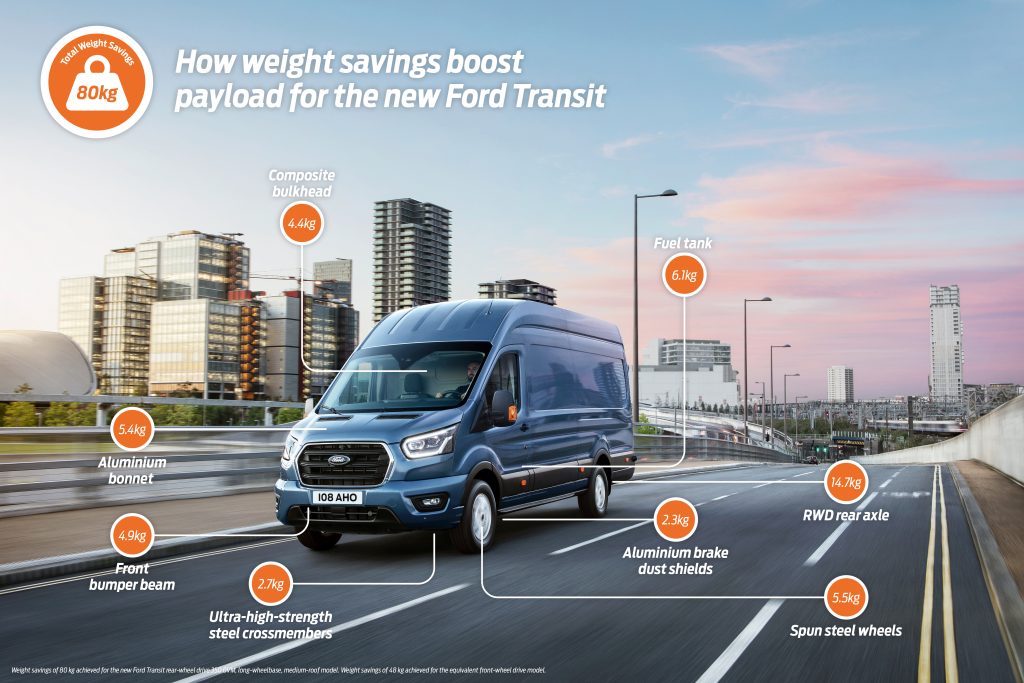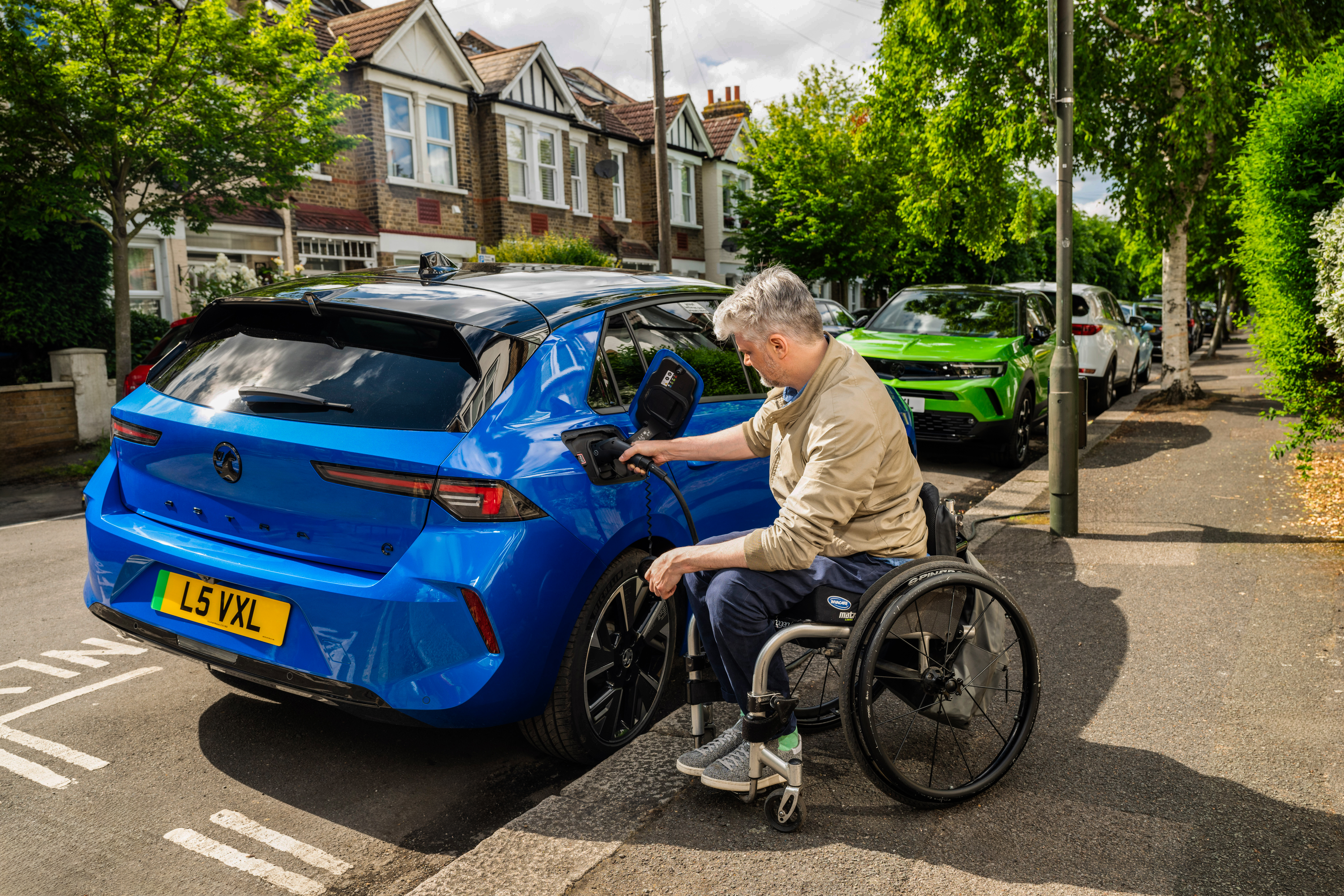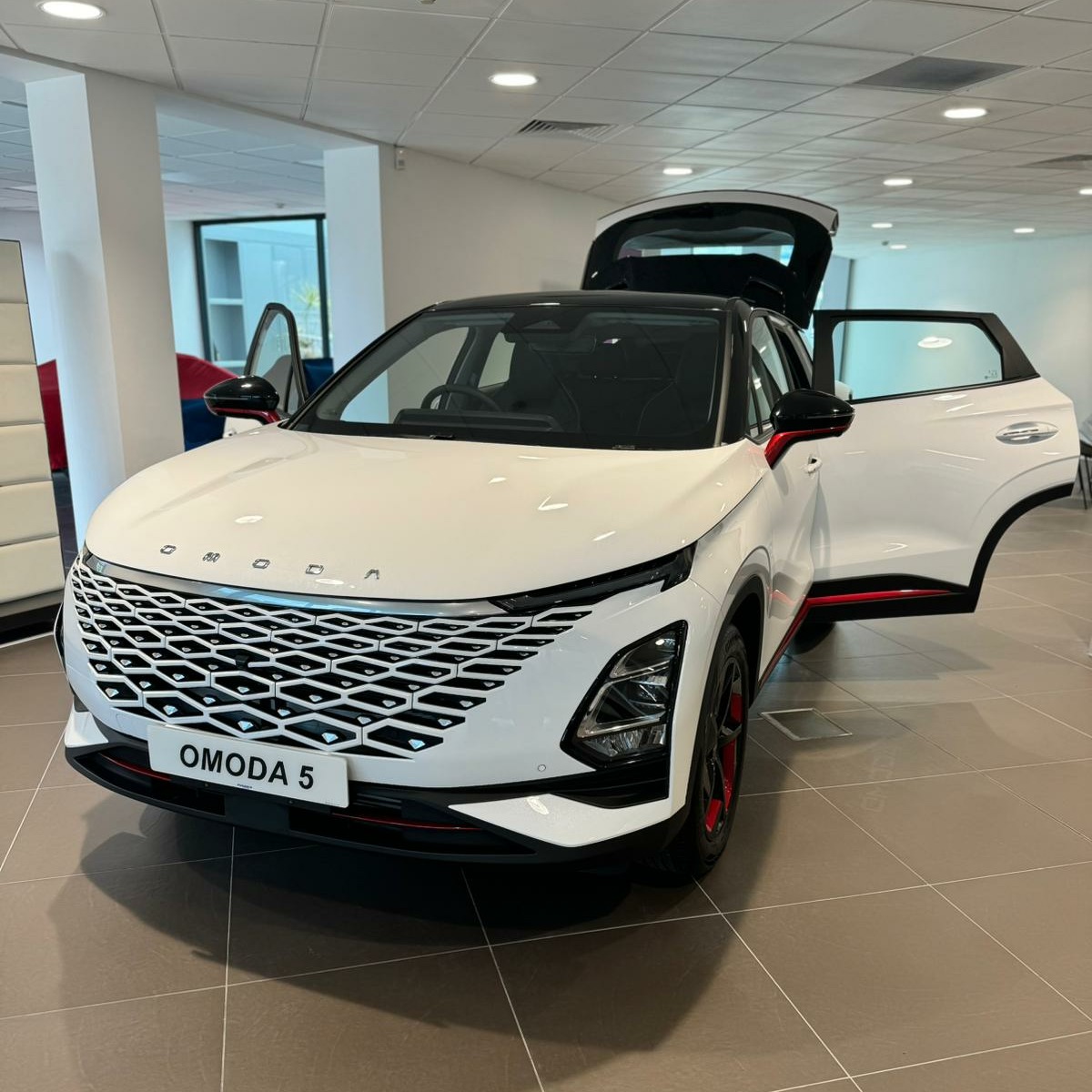The new Ford Transit will help operators to be even more productive when the better connected and more fuel-efficient 2-tonne van goes on sale in mid-2019, with up to 80 kg more load-carrying capability following a top-to-bottom programme of weight savings.
Sophisticated engineering including Ford’s first aluminium bonnet for a commercial vehicle in Europe, a composite bulkhead and spin-formed wheels were optimised during the development process using advanced computer-aided design (CAD) systems typically employed in the aerospace industry.
These are among the innovations that have helped Ford engineers reduce the kerb weight of the new Transit to enable customers to carry larger loads for greater operating efficiency. The new Transit rear-wheel drive 350 GVM, long-wheelbase, medium-roof model, for example, is 80 kg lighter than the comparable out-going model. The equivalent front-wheel drive van is 48 kg lighter.
“Payload is critical for businesses. Lighter weight also improves fuel efficiency and CO2 emissions, so every part of the Ford Transit team worked to a weight-saving target, while maintaining strength and durability as a priority,” said Michael McDonagh, Transit global chief programme engineer. “The increased payload further enhances the Transit’s reputation for outstanding productivity.”
The new Transit also enhances productivity for businesses with fuel efficiency improved by up to 7 per cent with a new powertrain offering that includes an upgraded 2.0-litre EcoBlue diesel line-up delivering CO2 emissions from 156 g/km;* a more powerful 185 PS variant; and a new 10‑speed automatic transmission for rear-wheel drive models. A segment-first EcoBlue Hybrid 48-volt mild-hybrid option further improves upon 2.0-litre EcoBlue fuel efficiency by up to an additional 8 per cent in stop-start urban applications, delivering CO2 emissions from 144 g/km.
New driver assistance tech and advanced new connectivity features make working days less stressful for operators, and FordPass Connect on-board modem technology will help fleet professionals to improve vehicle utilisation and optimise running costs.
Ford is the No. 1 commercial brand in Europe and Ford Transit range sales rose by 11.8 per cent in the first quarter of 2019 compared with the same period last year, with total sales of 81,700. Ford sold 380,900 commercial vehicles in its European 20 markets in 2018, up more than 8 percent compared with 2017.
Optimised weight delivers enhanced payload
Improved payload has been delivered through a comprehensive programme to optimise vehicle weight, while still enabling operators to benefit from the latest safety systems and driver assistance technologies.
Using a “marginal gains” approach, hundreds of components were optimised for weight, strength and durability using aerospace industry CAD software. Savings in every area of the vehicle, sometimes of less than 0.5 kg for each part, delivered a total saving of up to 80 kg like-for-like.
The new Transit’s lightweight aluminium bonnet saves 5.4 kg compared with a steel equivalent, without sacrificing strength. The new bonnet was comprehensively tested for dent resistance, and performs as well as a steel bonnet in temperatures between minus 30 degrees Celsius and 80 degrees Celsius.
Major savings of 14.7 kg were achieved by redesigning the rear axle for the rear-wheel drive model, and a new high-strength, lightweight composite bulkhead** saves 4.4 kg compared with a steel equivalent.
The new Transit’s steel wheels were produced using a spinning production technique that achieves greater strength using less metal. This approach delivers a total saving of 5.5 kg for Transit across five wheels, including the spare.
Enhanced fuel efficiency. More choice
In addition to the upgraded 2.0-litre EcoBlue diesel line-up, features contributing to increased fuel efficiency and reduced CO2 include the introduction of electric power-assisted steering (EPAS) to the Transit for the first time; the use of low-rolling-resistance tyres; and aerodynamic enhancements.
Fuel-saving Auto Start-Stop technology remains standard across the range. Drivers can also use EcoGuide, which uses GPS positioning to give predictive advice on how to achieve the best fuel efficiency on the road ahead.
Ford recently announced that a new all-electric Transit will join the company’s line-up of electrified commercial vehicles in 2021. Designed to deliver pure-electric propulsion, the new van will contribute to cleaner, quieter towns and cities, and reduced running costs for business and operators.***
Smarter design, smarter technologies
The Ford Transit’s smart new exterior features a taller, more assertive three-bar grille and a redesigned lower fascia. Inside the cabin, an all-new interior design delivers enhanced style, practicality and driver comfort, with advanced technologies including Ford’s SYNC 3 communications and entertainment system that can be operated using simple, voice commands, or via pinch and swipe gestures on an eight-inch touchscreen.
The Transit’s refined and car-like driving character is enhanced with the introduction of EPAS technology that also helps reduce driver fatigue by adding more assistance while parking and manoeuvring, and enables driver assistance technologies including Active Park Assist and Lane-Keeping Aid.
For the first time, Transit drivers will be able to choose from Selectable Drive Modes to match driving performance to conditions: Eco Mode, Slippery Mode, Mud/Rut Mode for all-wheel drive models and Tow/Haul Mode for smooth power delivery when towing large trailers or boats that weigh more than the vehicle kerb weight.
A comprehensive range of advanced driver assistance technologies have also been introduced to help reduce stress and tiredness, and to help avoid or mitigate the impact of collisions. These include:
- Blind Spot Information System with Trailer Tow system
- Intelligent Adaptive Cruise Control
- Enhanced Lane-Keeping System
- Pre-Collision Assist with Pedestrian Detection
New features are also provided to make life easier and less stressful when manoeuvring and parking within busy commercial and urban environments, and potentially avoid costly bumps and scrapes. These include Front and Rear Wide-View Cameras and a high mounted rear-view camera; Parking Aid, enhanced with additional side sensors; Park-Out Assist and Cross Traffic Alert.
###
Economy and emissions (sample figures)
| Ford Transit | CO2 NEDC CO2MPAS (g/km) | Fuel consumption WLTP Low-High (l/100 km/mpg) |
| 2.0-litre 105 PS EcoBlue, 6-speed manual | From 156 | 7.2-10.7 (26.4-39.2) |
| 2.0-litre 130 PS EcoBlue Hybrid, 6-speed manual | From 144 | 7.6-13.2 (21.4-37.2) |
*The declared fuel/energy consumptions, CO2 emissions and electric range are measured according to the technical requirements and specifications of the European Regulations (EC) 715/2007 and (EC) 692/2008 as last amended. Fuel consumption and CO2 emissions are specified for a vehicle variant and not for a single car. The applied standard test procedure enables comparison between different vehicle types and different manufacturers. In addition to the fuel-efficiency of a car, driving behaviour as well as other non-technical factors play a role in determining a car’s fuel/energy consumption, CO2 emissions and electric range. CO2 is the main greenhouse gas responsible for global warming.
Since 1 September 2017, certain new vehicles are being type-approved using the World Harmonised Light Vehicle Test Procedure (WLTP) according to (EU) 2017/1151 as last amended, which is a new, more realistic test procedure for measuring fuel consumption and CO2 emissions. Since 1 September 2018 the WLTP has begun replacing the New European Drive Cycle (NEDC), which is the outgoing test procedure. During NEDC Phase-out, WLTP fuel consumption and CO2 emissions are being correlated back to NEDC. There will be some variance to the previous fuel economy and emissions as some elements of the tests have altered i.e., the same car might have different fuel consumption and CO2 emissions.
**Optional in UK; steel is optional in markets where composite bulkhead is standard.
***Officially homologated fuel-efficiency and CO2 emission figures will be published closer to on-sale date





